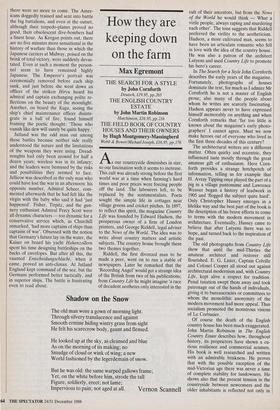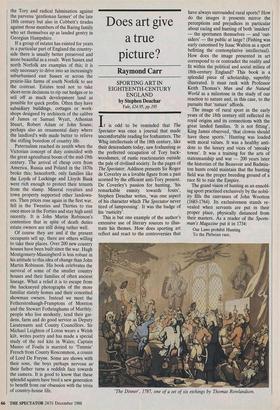How they are keeping down on the farm
Max Egremont
THE SEARCH FOR A STYLE by John Cornforth Deutsch, £19.95, pp.263 THE ENGLISH COUNTRY ESTATE by John Martin Robinson Hutchinson, £16.95, pp.216 THE FIELD BOOK OF COUNTRY HOUSES AND THEIR OWNERS by Hugh Montgomery-Massingberd Webb & Bower/Michael Joseph, £16.95, pp.176 As our countryside diminishes in size, so our fascination with it seems to increase. This cult was already strong before the first world war at a time when farming's hard times and poor prices were forcing people off the land. The labourers left, to be replaced by the sentimentalists. Poets sought the simple life in cottages near village greens and cricket pitches. In 1897, to reflect this spirit, the magazine Country Life was founded by Edward Hudson, the prosperous owner of a firm of London printers, and George Riddell, legal adviser to the News of the World. The idea was to write about country matters and artistic subjects. The country house brought these two themes together.
Riddell, the first divorced man to be made a peer, went on to run a stable of newspapers. Later he remarked that the 'Recording Angel' would get a strange idea of the British from two of his publications; from Country Life he might imagine 'a race of decadent aesthetes only interested in the cult of their ancestors, but from the News of the World he would think — What a virile people, always raping and murdering each other'. The tone suggests that Riddell preferred the virility to the aestheticism. Hudson, a more cultivated man, seems to have been an articulate romantic who fell in love with the idea of the country house. He was also a patron of the architect Lutyens and used Country Life to promote his hero's career.
In The Search for a Style John Cornforth describes the early years of the magazine.
Fortunately, photographs of houses dominate the text, for much as I admire Mr Cornforth he is not a master of English prose; also many of the people about whom he writes are scarcely fascinating.
Hudson appears never to have expressed himself memorably on anything and when Cornforth remarks that 'far too little is known about the magazine's early photo- graphers' I cannot agree. Must we now make heroes out of everyone who lived in the first three decades of this century?
The architectural writers are a different matter. Often quirky and eccentric, they influenced taste mostly through the great amateur gift of enthusiasm. Here Corn- forth provides a strange hotchpotch of information, telling us for example that H. Avray Tipping once played the part of a pig in a village pantomime and Lawrence Weaver began a history of leadwork in 1905 and 'flogged the subject quite hard'. Only Christopher Hussey emerges in a lifelike way and the best part of the book is the description of his brave efforts to come to terms with the modern movement in architecture. Eventually, Hussey came to believe that after Lutyens there was no hope, and turned back to the inspiration of the past.
The old photographs from Country Life show that until the mid-Thirties the amateur architect and restorer still flourished. E. G. Lister, Captain Colville and Colonel Cooper all stood out against architectural modernism and, with Country Life, kept alive a respect for tradition. Penal taxation swept them away and took patronage out of the hands of individuals, giving it to bureaucracies or committees to • whom the monolithic anonymity of the modern movement had more appeal. Thus socialism promoted the monstrous visions of Le Corbusier.
Of course the death of the English country house has been much exaggerated.
John Martin Robinson in The English Country Estate describes how, throughout history, its proprietors have shown a cu- rious resilience and commercial acumen.
His book is well researched and written with an admirable briskness. He proves that with the possible exception of the mid-Victorian age there was never a time of complete stability for landowners. He shows also that the present tension in the countryside between newcomers and the older inhabitants is reflected not only in the Tory and radical fulmination against the parvenu 'gentleman farmer' of the late 18th century but also in Cobbett's tirades against those members of the Baring family who set themselves up as landed gentry in Georgian Hampshire.
If a group of estates has existed for years in a particular part of England the country- side there is usually better preserved and more beautiful as a result. West Sussex and north Norfolk are examples of this; it is only necessary to drive into an increasingly suburbanised east Sussex or across the prairie-like farms of south Norfolk to see the contrast. Estates tend not to take short-term decisions to rip out hedges or to sell off as much development land as possible for quick profits. Often they have subsidiary buildings, cottages or work- shops designed by architects of the calibre of James or Samuel Wyatt, Athenian Stuart, Robert Adam or John Soane; perhaps also an ornamental dairy where the landlord's wife made butter to relieve the stifling boredom of country life.
Paternalism reached its zenith when the Victorian concept of duty coincided with the great agricultural boom of the mid-19th century. The arrival of cheap corn from America, Russia and Poland in the 1870s broke this; henceforth, only families like the Loyds of Lockinge and Lloyds Bank were rich enough to protect their tenants from the slump. Mineral royalties and town property supported other landown- ers. Then prices rose again in the first war, fell in the Twenties and Thirties to rise once more in the Forties and stay high until recently. It is John Martin Robinson's contention that in spite of death duties estate owners are still doing rather well.
Of course they are and if the present occupants sell up, there are others willing to take their places. Over 200 new country houses have been built since the war. Hugh Montgomery-Massingberd is less robust in his attitude to this idea of change than John Martin Robinson. His book celebrates the survival of some of the smaller country houses and their families of often ancient lineage. What a relief it is to escape from the hackneyed photographs of the more familiar stately homes and their conceited showman owners. Instead we meet the Fetherstonhaugh-Framptons of Moreton and the Stewart Fothringhams of Murthly: people who live modestly, tend their gar- dens, farm and do good service as Deputy Lieutenants and County Councillors. Sir Michael Leighton of Loton wears a Welsh kilt, writes poetry and has made a special study of the red kite in Wales; Captain Munro of Foulis is married to Tinunie' French from County Roscommon, a cousin of Lord De Freyne. Some are shown with their sons, the boys perhaps nervous as their father turns a reddish face towards the camera. It is good to know that these splendid squires have bred a new generation to benefit from our obsession with the trivia of country-house life.











































































































 Previous page
Previous page